Accessing IntentAI and Managing Intents
You can access IntentAI to manage AI-driven feature Intents to optimize network performance.
Accessing IntentAI from the Navigation Bar
To access IntentAI from the navigation bar, complete the following steps:
-
From the navigation bar, click
AI
Assurance > AI
Analytics > IntentAI.
The IntentAI page is displayed without any pre-selected filters, listing all available Intents in the table. You can apply custom filters as needed to view specific Intents.
IntentAI Page 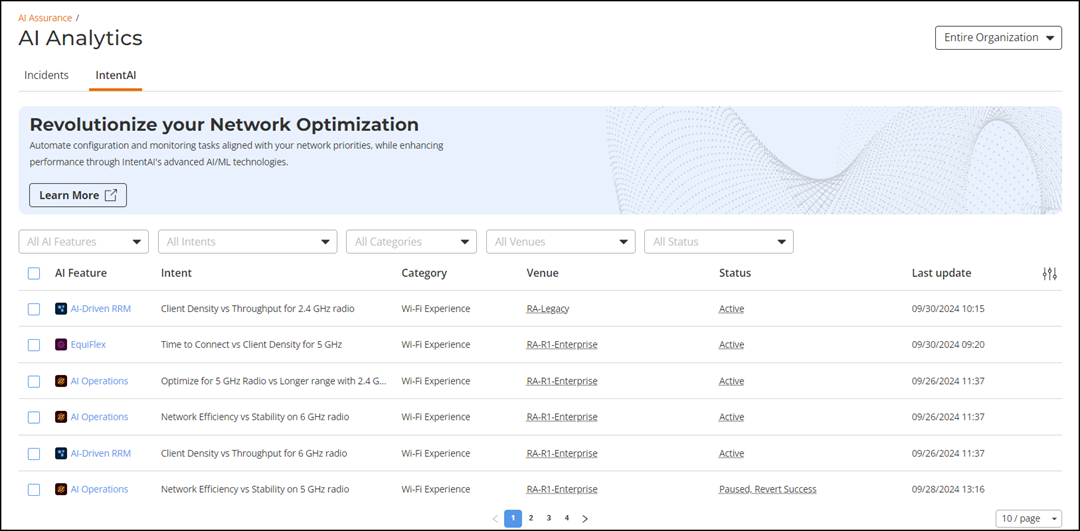
The IntentAI page provides a detailed view of all available network Intents in a table format, allowing users to manage and monitor Intents efficiently. The page includes several filters and attributes that enable you to narrow down the search and focus on specific Intents based on various criteria. The Network Hierarchy filter located at the top right of the UI helps to navigate through the organization’s network structure, filtering Intents based on specific network segments or hierarchy levels.
The About IntentAI interactive banner displays a widget for each available AI-driven feature. Each widget is clickable and dynamically filters the intents based on your selection. You can select multiple widgets to expand the scope of filtering. If an AI feature has no associated intents, its widget is automatically hidden. When no intents are available across all features, the entire banner is auto-minimized. You can also manually expand or collapse the banner using the up/down arrow control.
You can also narrow down the list of required Intents by Status, AI Feature, Intent, Category, and Venue. When the list of Intents spans multiple pages, you can choose how many Intents to display per page using the drop-down menu at the bottom of the page.
The Status filter groups individual intent statuses into the following action-related categories, with the number of intents displayed next to each category:- Action Needed: Filters the Intents that require user intervention to proceed.
- Auto Managed: Filters the Intents that are actively managed by IntentAI.
- No Action: Filters the Intents that are paused or inactive and do not require any action.
The Status filter has a two-level selection hierarchy, allowing you to filter Intents by action-related category or expand a category to choose specific underlying statuses for more refined filtering.
You can remove filters individually or clear them all at once. To remove a specific filter, click the 'x' button in the filter box. To clear all filters simultaneously, use the Clear Filters button.
The table on the IntentAI page consists of the following columns that summarize each Intent:- AI Feature: Displays the AI-driven feature associated with the Intent (for example AI Operations, AI-Driven RRM). This helps you to identify the AI functionality leveraged to generate the Intent.
- Intent: Describes the network objective or optimization the Intent focuses on. This provides a clear overview of the goals of each Intent.
- Category: Specifies the type of network optimization associated with the Intent, such as Wi-Fi Experience or Infrastructure.
- Venue: Displays the venue where the Intent is available.
- Status: Displays the current state of the
Intent.
The Intent progresses through various statuses during its workflow, depending on the actions taken. The status is set to New when an Intent is available but has not yet been applied. Once an Intent is scheduled for application, the status changes to Scheduled. After the scheduled Intent is successfully applied, the status updates to Active. If there is a failure during application, the status changes to Failed. If an applied Intent is later reversed, its status becomes Reverted. The actions available for an Intent vary depending on its current status. For more information on the full list of statuses and corresponding actions, refer to Table 1.
You can configure email notifications to receive updates whenever the status of an Intent changes. Once configured, each status change automatically triggers an email notification to the network administrator, providing detailed information about the update. If you had previously configured email notifications for recommendations, the settings may have been reset. To continue receiving notifications for IntentAI status changes, re-enable the email notification configuration.
For more information on configuring notifications, refer to the Configuring Global Notifications section.
- Last Update: Displays the latest timestamp when the Intent was updated.
Table 1. Intent Workflow Status and Available Actions Status Description Available Actions New IntentAI has analyzed the data and generated a change recommendation that is awaiting your approval. To review the details, specify Intent priority, and apply the recommendations, use the Optimize option. Alternatively, use the 1-Click Optimize option to instantly apply the changes with default priority.
Optimize, 1-Click Optimize, or Pause Scheduled The change recommendation has been scheduled either automatically by IntentAI or through user actions such as Optimize or 1-Click Optimize. Edit, Revert, or Cancel The Cancel option is not applicable for Intents automatically scheduled by the system.
Apply in Progress IntentAI-recommended changes are currently being applied to the venue.
Not Applicable Active Intent is active and has successfully applied the changes to the venue.
Edit, Revert, or Pause Paused, Applied Failed The recommended changes from IntentAI failed to apply to the venue, and the Intent is now paused. To process new data and generate updated recommendations using ML algorithms, select the Resume action.
Revert or Resume Revert Scheduled A reversion of the IntentAI-recommended changes has been scheduled. Revert or Cancel Revert in Progress The recommended changes from IntentAI are being reverted to the previous configuration. Not Applicable Paused, Revert Failed The reversion of the IntentAI-recommended changes has failed, and the Intent is currently paused. To process new data and generate updated recommendations using ML algorithms, select the Resume action. Revert or Resume Paused, Revert Success The reversion was successful, and the Intent is currently paused. To process new data and generate updated recommendations using ML algorithms, select the Resume action. Resume Verified IntentAI has validated the venue configurations. No new changes have been recommended. It will continue to monitor the venues and raise a recommendation if an improvement is required.
Optimize, 1-Click Optimize, or Pause Paused The Intent is paused by the user action Pause. A paused Intent will not execute any tasks, including KPI measurement, ML model generations, recommendation generation, or configuration changes. Resume No Recommendation, No APs No recommendation was generated because IntentAI did not find any APs in the venue.
Pause No Recommendation, Not Enough Data No recommendation was generated due to insufficient data in the venue.
Pause No Recommendation No recommendation is currently available. The system is awaiting data processing and recommendation generation by the ML algorithms. Pause No Recommendation, Conflicting Configuration No recommendation was generated because IntentAI detected conflicting configurations in the venue.
This status is displayed in the following scenarios:- When more than 20% of the APs in the venue have configurations with AP overrides.
- When the venue has active mesh APs.
Pause Note: If a venue is deleted, IntentAI may show the deleted venue with a status of either 'Paused' or 'No Recommendation, No APs'.
Applying an Intent Using the 1-Click Optimize Option
The following task example shows how to apply an AI-Driven RRM Intent. Complete the following steps to apply the Intent using the 1-Click Optimize option.
- From the navigation bar, click AI Assurance > AI Analytics > IntentAI. The IntentAI page is displayed.
- In the IntentAI table, select the Intent with the status labeled New.
-
Click 1-Click Optimize at the top of the IntentAI
table. A confirmation dialog box is displayed.
1-Click Optimize Confirmation Dialog Box 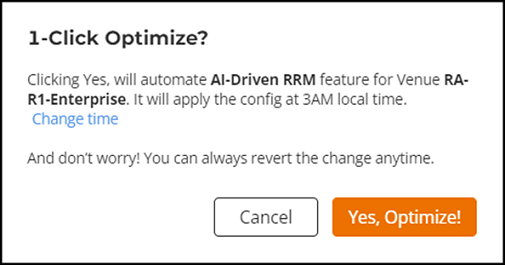
-
Optionally, click the
Change
time option if you want to schedule a different date and
time for applying the Intent, other than the system’s default. The system
retains this scheduled time for future use, which IntentAI leverages daily
to implement any necessary adjustments. If any subsequent network
configuration changes are detected, the Intent will be automatically applied
at the same time as the originally scheduled time each day, ensuring
consistent optimization based on the latest network conditions.
Choose off-peak hours, when the number of Wi-Fi clients are at a minimum, to apply the changes. The time you select is based on your browser's time zone. If the APs are located in a different time zone, adjust the scheduled time accordingly to ensure changes occur during off-peak hours.
-
Click Yes, Optimize
to enable the Intent to be applied at the scheduled time.
Additionally, this feature supports bulk optimization, allowing you to select and apply multiple Intents simultaneously to optimize the network efficiently.
Applying an Intent Using the Optimize Option
The following task example shows how to apply an AI-Driven RRM Intent. The workflow wizard remains consistent across other AI-feature Intents, but there will be specific variations in the Intent details, KPIs, Intent priority, and summary information based on the AI-feature being applied. For example, Intents for AI Feature type AI Operations do not include Projection and Metrics panels of information.
Complete the following steps to apply an Intent using the Optimize option.
- From the navigation bar, select AI Assurance > AI Analytics > IntentAI. The IntentAI page is displayed.
- In the IntentAI table, select the Intent with the status labeled New.
-
Click Optimize at the top of the IntentAI table.
A workflow wizard is displayed to guide you through the
configuration.
AI-Driven RRM Optimization Workflow - Introduction 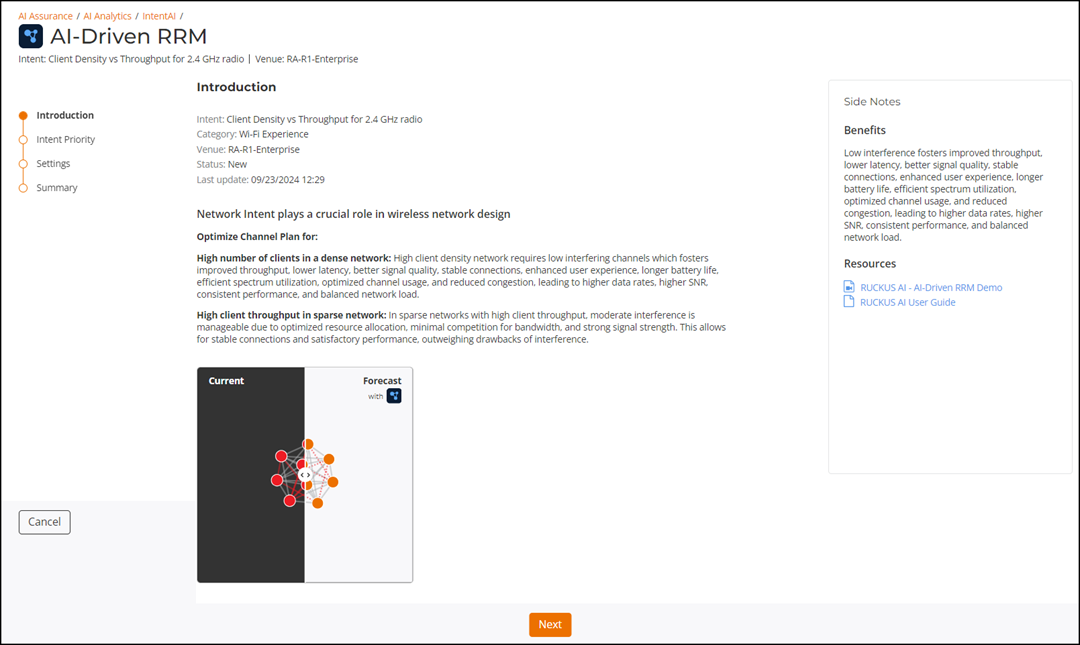 The Introduction page of the workflow wizard provides a snapshot of the Intent details such as the venue, status, the date on which the Intent was last updated, a brief description of the network Intents, and the benefit of applying the recommended change.The Projection panel displays a comparative view of the current RF environment and expected changes in the RF environment when the selected Intent is applied. It includes two tabs, Interfering Links and Neighbor AP Graph, that provide side-by-side visualizations of current and projected interference levels and neighboring AP metrics, respectively. It highlights how applying the recommended Intent can reduce co-channel interference, improve channel utilization, and create a more balanced and efficient neighboring AP environment, providing a clear before-and-after snapshot.
The Introduction page of the workflow wizard provides a snapshot of the Intent details such as the venue, status, the date on which the Intent was last updated, a brief description of the network Intents, and the benefit of applying the recommended change.The Projection panel displays a comparative view of the current RF environment and expected changes in the RF environment when the selected Intent is applied. It includes two tabs, Interfering Links and Neighbor AP Graph, that provide side-by-side visualizations of current and projected interference levels and neighboring AP metrics, respectively. It highlights how applying the recommended Intent can reduce co-channel interference, improve channel utilization, and create a more balanced and efficient neighboring AP environment, providing a clear before-and-after snapshot.- The Interfering Links tab displays a comparative graph that shows the current configuration, including the number of interfering links discovered in a venue and the expected state after applying the recommended AI-Driven RRM Intent. This graph highlights how APs with interfering links in the current state can, after applying the recommended Intent, transition to a state with reduced interfering links, showcasing a before-and-after improvement in the RF environment. It helps to understand how the recommended Intent reduces co-channel interference and balances RF conditions. Click View More to view the interactive graph with granular details and zoom in or zoom out capability; pausing your cursor over any dot will bring up a side-by-side example that further identifies specific APs as well as the proposed changes.
- The Neighbor AP Graph tab displays a comparative view of the average metrics for neighboring APs in the current state and the expected state after applying the recommended AI-Driven RRM Intent. These metrics include co-channel interfering APs that can cause signal interference and degrade network performance, non-interfering APs that operate on different channels, and rogue APs that may pose security risks or act as interference sources. This data helps to assess RF congestion, plan channels proactively, mitigate interference, and enforce wireless security policies. Click View More to access a detailed expanded view of the graph.
The Metrics panel provides quantitative insights into Wi-Fi channel allocation and transmit power level distribution across APs, enabling analysis of channel usage density, identification of power imbalances, and fine-tuning of RF settings to enhance overall network performance.- The Channel Distribution histogram displays Wi-Fi channel allocation across all APs in the network. It helps visualize the spread and density of channel usage, enabling identification of channel crowding, overlapping usage, or imbalances in channel planning. This insight supports more effective channel allocation, reducing interference, and maximizing overall network efficiency.
- The Power Transmission histogram displays the distribution of transmit power levels configured across APs. It reflects how much RF power APs are using to communicate with clients highlighting uneven or suboptimal power settings - either too high, causing interference, or too low, leading to coverage gaps. This insight helps to fine-tune RF performance for consistent and reliable connectivity across the deployment.
-
Click Next to move to the Intent
Priority page of the workflow wizard.
AI-Driven RRM Optimization Workflow - Intent Priority 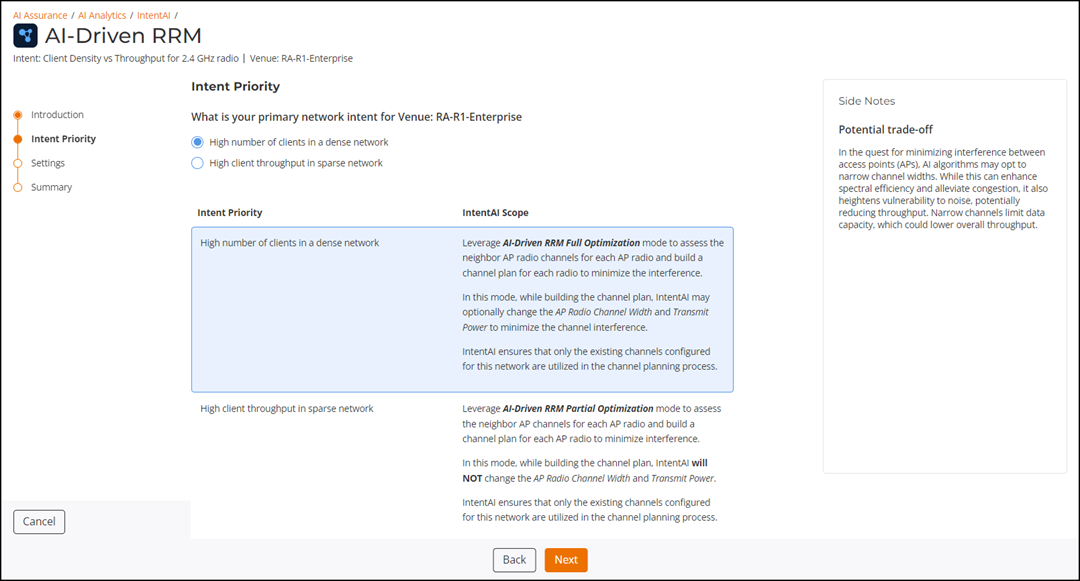 The system typically presents two configuration options based on specific network priorities that define the user intent. While IntentAI recommends the best course of action by default, you can override this recommendation and select the alternative Intent based on your desired goal for network optimization. For more information about feature-specific Intents and priority details, refer to AI Feature-specific Intents, Network Priorities, and Scope.
The system typically presents two configuration options based on specific network priorities that define the user intent. While IntentAI recommends the best course of action by default, you can override this recommendation and select the alternative Intent based on your desired goal for network optimization. For more information about feature-specific Intents and priority details, refer to AI Feature-specific Intents, Network Priorities, and Scope.The page also displays a Potential trade-off box that outlines the key considerations you should be aware of before applying the recommendation. It describes the scope of venue-level configuration changes that will be applied and the potential impact on the network after applying the recommendation.
- Click the radio button to select the Intent priority of your choice.
-
Click Next to move to the
Settings page of the workflow wizard.
AI-Driven RRM Optimization Workflow - Settings 
-
Select the date and time in the calendar to schedule the time at which
you want to apply the recommendation.
The system retains this scheduled time for future use, which IntentAI leverages daily to implement any necessary adjustments. If any subsequent network configuration changes are detected, the Intent will be automatically applied at the same time as the originally scheduled time each day, ensuring consistent optimization based on the latest network conditions.
-
Click Next to move to the
Summary page of the workflow.
AI-Driven RRM Optimization Workflow - Summary 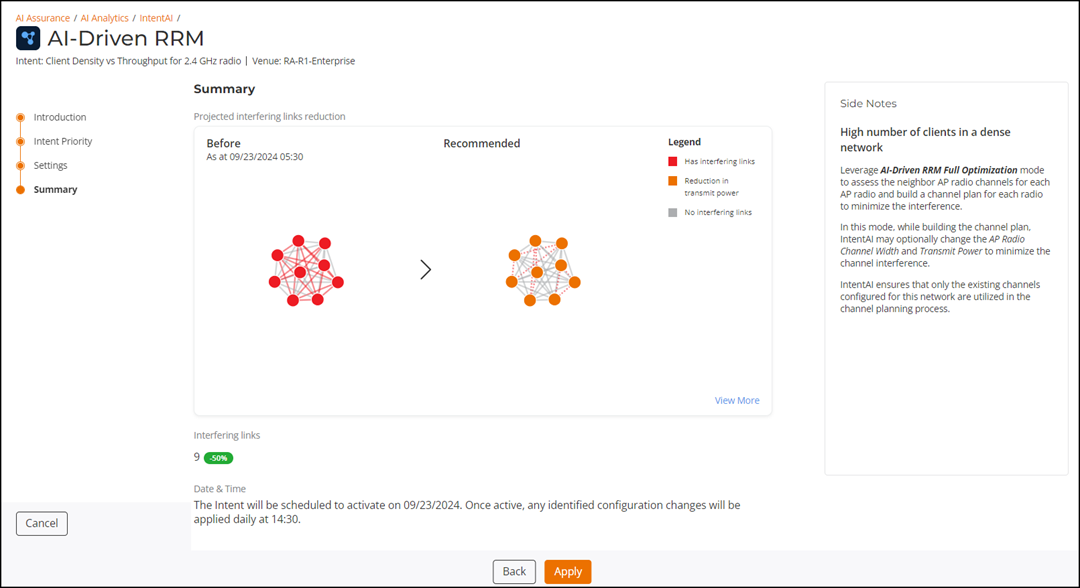 The Summary page provides a quick summary of the configuration recommendation and schedule of the Intent activation
The Summary page provides a quick summary of the configuration recommendation and schedule of the Intent activation -
Click Apply to enable the recommendation to be
applied at the scheduled time.
Intents that are applied successfully are also reflected on the Config Change page. For more information, refer to the Configuration Change section.
Reverting an Intent
Complete the following steps to revert an Intent.
- From the navigation bar, click AI Assurance > AI Analytics > IntentAI. The IntentAI page is displayed.
-
In the IntentAI table,
select the Intent you want to revert.
The Revert option is available based on the status of the Intent. For more details on statuses and their corresponding actions, refer to Table 1.
- Click Revert at the top of the IntentAI table. A calendar prompt is displayed for scheduling.
- Select the date and time in the calendar to schedule the time at which you want to revert the Intent.
-
Click Apply to enable the recommendation to be reverted at the
scheduled time.
You can revert multiple Intents simultaneously. However, only Intents with the same status (that support the Revert action) can be reverted in bulk.
Pausing an Intent
Complete the following steps to pause an Intent.
- From the navigation bar, click AI Assurance > AI Analytics > IntentAI. The IntentAI page is displayed.
-
In the IntentAI table,
select the Intent you want to pause.
The Pause option is available based on the status of the Intent. For more details on statuses and their corresponding actions, refer to Table 1.
-
Click Pause at the
top of the IntentAI table. The selected Intent will remain in its current
state until resumed.
You can pause multiple Intents simultaneously. To pause Intents in bulk, select multiple Intents (with the statuses that support the Pause action) and click Pause.
Resuming an Intent
The Intent's workflow for the venue will be triggered at the predefined time, allowing the system to continue optimizing network performance.
Complete the following steps to resume an Intent.
- From the navigation bar, click AI Assurance > AI Analytics > IntentAI. The IntentAI page is displayed.
-
In the IntentAI table,
select the Intent you want to resume.
The Resume option is available based on the status of the Intent. For more details on statuses and their corresponding actions, refer to Table 1.
-
Click Resume at the
top of the IntentAI table. The selected Intent will restart and resume
automated assessment and recommendation generation at the predefined
time.
You can resume multiple Intents simultaneously. However, only Intents with the same status (that support the Resume action) can be resumed in bulk.
Editing an Intent
Complete the following steps to edit an Intent.
- From the navigation bar, click AI Assurance > AI Analytics > IntentAI. The IntentAI page is displayed.
-
In the IntentAI table,
select the Intent you want to edit.
The Edit option is available based on the status of the Intent. For more details on statuses and their corresponding actions, refer to Table 1.
- Click Edit at the top of the IntentAI table. The Intent workflow wizard page opens, allowing you to modify the Intent's priority and scheduled time.
-
Make the necessary changes
and click Apply.
The Edit option is applicable only to individual Intents; multiple Intents cannot be edited simultaneously.
Canceling an Intent
Complete the following steps to cancel an Intent.
- From the navigation bar, click AI Assurance > AI Analytics > IntentAI. The IntentAI page is displayed.
-
In the IntentAI table,
select the Intent you want to cancel.
The Cancel option is available based on the status of the Intent. For more details on statuses and their corresponding actions, refer to Table 1.
-
Click Cancel at the
top of the IntentAI table to cancel the Intent.
You can cancel multiple Intents simultaneously. However, only Intents with the same status (that support the Cancel action) can be canceled in bulk.